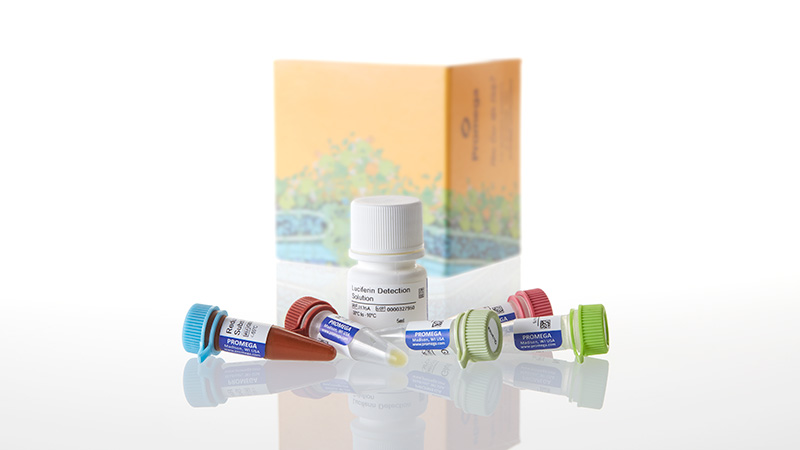인류의 건강과 생명공학 발전을 위해 봉사하는 기업 드림셀
We Serving the Health and Biotechnology of Humanity
We Serving the Health and Biotechnology of Humanity

제품코드 : J7021
제품정보 : Energy Metabolism Assay
Glutamate is an important metabolite, serving as a precursor for the synthesis of nucleic acids, nucleotides and proteins. Glutamate is also a key neurotransmitter in nerve cells. Upregulated glutamate production is used as a marker of increased cancer cell dependence on glutaminolysis to support high proliferation rates. The Glutamate-Glo™ Assay is a suitable assay for measuring changes in glutamate levels in a variety of samples, and the assay is sensitive enough to detect even intracellular amounts of glutamate.
Glutamate dehydrogenase uses glutamate and NAD+ to produce α-ketoglutarate and NADH. In the presence of NADH a pro-luciferin Reductase Substrate is converted by Reductase to luciferin that is then used by Ultra-Glo™ Recombinant Luciferase to produce light.
When Glutamate Detection Reagent, which contains glutamate dehydrogenase (GlutDH), NAD+, Reductase, Reductase Substrate and Luciferase, is added to a sample containing glutamate at a 1:1 ratio, the enzyme-coupled reactions start and run simultaneously. The luminescent signal is proportional to the amount of glutamate in the sample and increases until all glutamate is consumed, at which time a stable luminescent signal is achieved.

The Glutamate-Glo™ Assay is a versatile system that is amenable to high-throughput formats and compatible with many sample types. Samples may require upfront sample processing, including dilutions, to fit into the linear range of the assay. They may also require inactivation of endogenous enzyme activity/deproteinization and NAD(P)H degradation (recommendations in technical manual). To simplify sample processing, methods for rapid enzyme inactivation and NAD(P)H degradation are provided that are compatible with 96- and 384-well plates and do not require sample centrifugation or spin columns.
Quickly Measure Metabolites in a Variety of Sample Types: Measure in media, cells, tissue and plasma. The assays require minimal preparation steps with no need for centrifugation and spin columns.
Conduct easy in-well processing for intracellular detection.
Measure Across a Wide Range of Concentrations: Broad linearity up to 3 logs enables simple sample measurement.
Detect Small Changes: Wide assay window with S/Bmax > 100 allows better discrimination of small changes in metabolite levels compared to colorimetric and fluorometric assays.
Gain More Information Per Sample: The assays are amenable to measuring multiple metabolites from the same sample. Multiplex with cell viability assays for normalization.

Easily measure changes in cellular glycolysis and glutaminolysis by sampling medium over time. Direct measurement of four metabolites important to the energetic state of the cell—glucose, lactate, glutamate and glutamine—can be performed in parallel using the bioluminescent Glucose-Glo™, Lactate-Glo™, Glutamine/Glutamate-Glo™ and Glutamate-Glo™ Assays. No specialized instrument, plates or artificial medium is required. Sample processing compatible with all of the bioluminescent metabolite assays means the same sample can be used for detecting all four metabolites. This includes sample types such as culture medium, serum, plasma and tissue. The data below were produced by measuring metabolites using medium samples from the same cell cultures as described in Technical Manual TM494.



